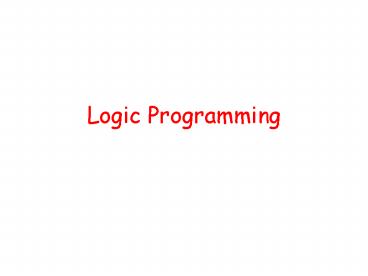Logic Programming - PowerPoint PPT Presentation
1 / 21
Title:
Logic Programming
Description:
( car set1) set2) (overlap? ( cdr set1) set2) overlap(X,Y) :- member(M,X), member(M,Y) ... Correspondence between Horn clauses and predicates ... Horn Clauses ... – PowerPoint PPT presentation
Number of Views:30
Avg rating:3.0/5.0
Title: Logic Programming
1
Logic Programming
2
Announcements
- Test No. 5 This Friday
- Since Last Exam 50
- Event-driven programming
- Logic programming
- Previous lessons 50
- Emphasis on concepts that should carry over
beyond the course - Hint Review missed questions in previous tests
- Multiple Choice
- Closed book closed notes
- Homework 8 is also due
3
Logic Programming
- Algorithm logic control
- Lot of effort in programming is to manage control
- Logic programming separates them
- Use facts and rules to represent information
- Use deduction to answer queries
4
Logic Programming
- (define overlap?
- (lambda (set1 set2)
- (cond
- ((null? set1) f)
- (else (or
- (member? (car set1) set2)
- (overlap? (cdr set1) set2)))))))
overlap(X,Y) - member(M,X), member(M,Y).
5
Declarative Programming
- Programmer declares the goals of the computation
- Not the detailed algorithm by which the goals can
be reached - Two major domains
- Databases, e.g. SQL
- Artificial intelligence (Prolog)
- Logic Programming
- Express the computation using mathematical logic
- Motivated by natural language processing and
automatic theorem proving
6
Logic Programming
- Prolog is the principal language
- Based on two powerful principles
- Resolution
- Unification
- Two interesting features
- Nondeterminism find multiple solutions
- Backtracking part of the language
7
Propositional Logic
- Provides the formal foundation for Boolean
expressions in languages - Basic Rules
8
Propositional Logic
- Precedence of operators
- Negation, conjunction, disjunction, implication,
equivalence - Propositions provide symbolic representation for
logic expressions - Can be interpreted as true or false.
9
Propositional LogicExample
- p Mary speaks Russian
- q Bob speaks Russian
- p?q Either Mary or Bob speak Russian
- p?q Both Mary and Bob speak Russian
- r Bob and Mary can communicate with each other
- p?q?r true
10
Predicate Logic
- Includes all of Propositional logic
- Includes additional entities
- Variables in various domains
- Boolean valued functions
- Quantifiers
11
Predicate LogicExamples
True if x is between 0 and 1 false otherwise
True if both speak Russian means x talks with y
True if everybody speaks Russian
True if for every person can speak a language
12
Properties of Predicate Logic
13
Predicate Logic
- Tautology Propositions that are true for all
possible values of variables - p?p
- Satisfiability Predicates that are true for some
particular assignment of variables - speaks(x,Russian) (not valid)
- Validity Predicates that are true for all
possible assignments of values to the variables - even(x)?odd(x)
14
Horn Clauses
- Consists of two parts
- Head (predicate)
- Body (a set of predicates)
- h is true if the predicates in the body are all
true simultaneously - i.e. logical conjunction
15
Horn Clauses
- Example
- snowing(city)?precipitation(city),freezing(city)
- Correspondence between Horn clauses and
predicates - precipitation(city),freezing(city)? snowing(city)
- Equivalent to
- ?(precipitation(city)?freezing(city))?
snowing(city) - ?precipitation(city) ?? freezing(city) ?
snowing(city)
16
Horn Clauses
- Underlying representation for Prolog
- Any Horn clause can be written as a predicate
- Not all predicates can be written as Horn clauses
- Systematic procedure exists to convert a
predicate into a Horn clause - Can be automated
17
Horn Clauses
- Eliminate implication using the following rule
- p?q is equivalent to ?p?q
- Move negation inward in p using deMorgan and
quantification properties so that only individual
terms are negated - ?(p?q) is equivalent to ?p??q
18
Horn Clauses
- Eliminate existential quantifiers
- Replace the existentially quantified variable by
a unique constant - ?x p(x) is replaced by p(c), c is a constant
- Called skolemization
- Move all universal quantifiers to the beginning
of p and then drop them - Avoid naming conflicts
- Does not change the meaning of p
19
Horn Clauses
- Use Distributive, Associative and Commutative
properties to convert p to a conjunctive normal
form - Conjunction of disjunctions
- Convert embedded disjunctions to implications in
the Horn clause format
20
Horn ClausesExample
literate(x)?writes(x) literate(x)
?reads(x,y),book(y)
21
Horn ClausesExample
- Conversion of a predicate to CNF does not
guarantee a set of Horn clauses - Example
- ?x(literate(x)?reads(x)?writes(x))
- ?literate(x)?reads(x)?writes(x)
- literate(x)?reads(x)?writes(x)
- Not a single term (head) in the right































